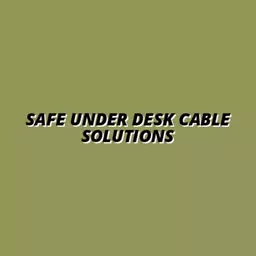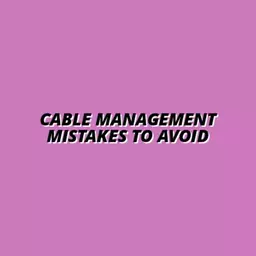
Safe Under Desk Installations Guide
Creating a workspace that prioritizes safety and productivity is essential. A well-structured under-desk installation not only enhances your work efficiency but also ensures your well-being by reducing the risk of hazards. Understanding the nuances of your workspace can lead to significant improvements in both comfort and safety.
What You Will Learn
- The significance of maintaining a safe and organized under-desk environment to enhance productivity and well-being.
- Common risks associated with under-desk setups, such as ergonomic hazards, equipment damage, and fire risks.
- The importance of a holistic safety approach that includes ergonomic considerations, secure equipment mounting, and efficient cable management.
- Key OSHA regulations relevant to under-desk installations, ensuring compliance and safety for users.
- The necessity of conducting regular safety audits to identify risks and maintain a secure workspace.
- Practical tips for implementing a safety checklist that covers ergonomic setups and cable organization.
Key Considerations for a Safer Workspace
Understanding the risks and safety measures for under-desk setups can significantly enhance your work environment.
Common Risks
- Ergonomic Hazards
- Equipment Damage
- Fire Hazards
- Structural Integrity
Safety Audit Steps
- Inspect Ergonomics
- Check Equipment Mounting
- Assess Cable Management
- Review Emergency Exits
Ergonomic Considerations
Maintain desk height that allows elbows at 90-degree angles while typing.
Cable Management Tips
Use trays and clips to organize cables and prevent tripping hazards.
Understanding Safety Considerations for Under Desk Installations
When it comes to creating an organized workspace, safety is paramount, especially with under-desk installations. These areas can often become chaotic with cables and equipment, leading to potential hazards. It's essential to consider user health and the longevity of your equipment when setting up these spaces. A well-planned under-desk setup not only enhances productivity but also ensures a safer working environment.
The Importance of a Safe Work Environment
Safety considerations in under-desk installations should not be taken lightly. A cluttered workspace can lead to accidents, injuries, and even damage to your equipment. By prioritizing safety, you’re investing in a healthier work environment that promotes well-being and efficiency.
Think about it: when you’re surrounded by a clean and organized space, it’s easier to focus on your tasks and maintain good posture. This directly impacts not only your physical health but also your overall productivity. It's a win-win situation!
Common Risks Associated with Under Desk Installations
Understanding the risks involved in under-desk setups is crucial for maintaining a safe workspace. Some of the primary hazards include:
- Ergonomic hazards: Poor desk setup can lead to discomfort and long-term health issues.
- Equipment damage: Cables that are not properly managed can cause wear and tear on your devices.
- Fire hazards: Overloaded power strips or improperly secured equipment can increase fire risks.
- Structural integrity: Insufficient support for heavy equipment can lead to collapses, posing danger to users.
Awareness of these risks allows you to take proactive steps in creating a safe under-desk environment. At Under-Desk Tray Hub, we believe that a well-organized space fosters not only safety but also productivity. By addressing these common hazards, you can ensure your workspace remains efficient and secure. For more detailed guidance, explore our article on safe cable management for offices.
Ergonomic Safety: Creating a Comfortable Workspace
Creating a comfortable workspace goes hand in hand with safety. One of the key factors in achieving this is ensuring that there’s enough space under your desk for leg movement and proper posture.
💡 Want to master under-desk cable trays? Start with our foundational guide to all things cable management. 👉 Read the Cable Management 101 Guide
When designing your workspace, consider the dimensions and layout of your under-desk area. Having sufficient clearance can greatly improve your overall comfort and reduce the risk of developing ergonomic-related issues. A well-planned setup can lead to a more enjoyable and productive workday!
Quick Summary
Here's a brief recap of the key points discussed so far:
- Safety is crucial for under-desk installations to prevent accidents and equipment damage.
- Common risks include ergonomic hazards, equipment damage, fire risks, and structural integrity issues.
- Regular safety audits and adherence to OSHA regulations are essential for maintaining a safe workspace.
- Implementing a safety checklist can streamline the process and ensure comprehensive safety measures are in place.
Mitigating Risks: A Holistic Safety Approach
Creating a safe workspace is more than just a checklist; it's a holistic approach that combines several key elements. By integrating ergonomic considerations, secure equipment mounting, and efficient cable management, we can craft a workspace that not only minimizes risks but also enhances productivity! Our aim at Under-Desk Tray Hub is to ensure you feel comfortable and safe, allowing you to focus on what truly matters—your work.
To truly embrace this holistic approach, consider the following elements:
- **Ergonomics:** Ensure that your desk setup promotes healthy postures and reduces strain.
- **Hardware Safety:** Use secure mounting solutions to prevent equipment from falling or shifting.
- **Cable Management:** Organize cables to avoid tripping hazards and potential damage.
When all these components are carefully designed and executed, you create a space that not only feels good to work in but also safeguards your health and equipment. It's like putting on a seatbelt; you may not always think about it, but when you need it, you’ll be grateful to have it! For information on selecting the right components, see selecting cable management solutions.
Regulatory Compliance for Home and Office Installations
Staying compliant with safety regulations is crucial, especially when it comes to under-desk installations. The Occupational Safety and Health Administration (OSHA) provides guidelines that ensure safe practices in both home and office environments. Being aware of these regulations helps protect not just you, but anyone who shares your workspace.
Key OSHA regulations applicable to under-desk installations include:
- **Proper Electrical Wiring:** Ensure that all cords and connections meet electrical standards.
- **Ergonomic Standards:** Follow guidelines for desk height and workspace design to promote user comfort.
- **Cable Management Requirements:** Maintain clear pathways to avoid tripping hazards.
By understanding and adhering to these regulations, you can foster a work environment that is both compliant and safe. It’s your responsibility to ensure that every person in your workspace can operate without unnecessary risks!
Conducting Safety Audits for Workspaces
Regular safety audits are essential to maintaining a safe work environment. These inspections help identify potential risks and allow for proactive adjustments before any accidents occur. Think of safety audits as your workspace’s health check-up!
When conducting a safety audit, consider the following steps:
- **Inspect Ergonomics:** Evaluate desk height and seating arrangements.
- **Check Equipment Mounting:** Ensure all devices are securely fastened.
- **Assess Cable Management:** Look for loose cables and tripping hazards.
- **Review Emergency Exits:** Confirm that pathways remain clear and accessible.
Regular audits not only keep safety in check but also demonstrate a commitment to a healthy workspace. At Under-Desk Tray Hub, we believe every little step contributes to a safer, more productive environment! Learn more about performing under-desk cable safety inspections to maintain a secure workspace.
Engaging with Your Workspace: FAQs and Common Concerns
Frequently Asked Questions on Under Desk Safety
It's natural to have questions about creating a safe workspace. Here are some frequently asked questions to guide you:
-
Why is under-desk safety important?
Under-desk safety is crucial to prevent accidents, equipment damage, and health issues related to poor ergonomics.
-
What are common under-desk hazards?
Common hazards include ergonomic issues, such as poor posture, equipment damage from unmanaged cables, and fire risks from overloaded power sources.
-
How can I improve ergonomics under my desk?
Ensure adequate space for leg movement, maintain correct desk and chair height, and use ergonomic accessories to promote good posture.
-
What steps should I include in a safety audit?
Safety audits should include inspecting ergonomics, checking equipment mounting, assessing cable management, and reviewing emergency exits.
-
What are the key OSHA regulations for under-desk installations?
Key OSHA regulations include proper electrical wiring, ergonomic standards for desk setup, and cable management requirements to avoid tripping hazards.
-
How often should I conduct a safety audit?
Regular safety audits should be conducted at least quarterly or whenever there are changes to your workspace setup.
-
What should be included in a safety checklist for under-desk installations?
A safety checklist should cover evaluating desk and chair height, checking equipment mounts, organizing cables, and reviewing compliance with OSHA standards.
Some common inquiries include:
- **What is the best height for my desk?** Aim for a height that allows your elbows to remain at a 90-degree angle while typing.
- **How can I protect my cables from damage?** Use cable trays and clips to keep everything organized.
- **Is there a risk of overheating with mounted equipment?** Always ensure proper ventilation around devices to prevent overheating.
Addressing these concerns can help you create a safer and more comfortable workspace. Remember, an informed user is a safe user!
Visual Aids for Safe Installation Practices
Visual aids can significantly enhance your understanding of safe installation practices. Diagrams and infographics can illustrate key points, making it easier to grasp the do's and don'ts of workspace organization. Consider incorporating:
- **Diagrams that show proper desk setups** compared to unsafe arrangements.
- **Infographics detailing cable management tips** and ergonomic practices.
- **Step-by-step guides for mounting equipment safely** under desks.
At Under-Desk Tray Hub, we often recommend these visual aids because they’re a fantastic way to reinforce learning and ensure safety procedures are followed diligently!
Taking Action for a Safer Workplace
Implementing a Safety Checklist for Under Desk Installations
One of the best ways to ensure safety in your workspace is by implementing a comprehensive checklist. This checklist should cover all aspects of what we’ve discussed, from ergonomic setups to cable organization. Here’s a quick guide to get you started:
- **Evaluate your desk and chair height** for ergonomic alignment.
- **Check all equipment mounts** and fastenings for security.
- **Organize cables** using trays and clips to prevent hazards.
- **Review compliance with OSHA standards** to ensure safety.
By using a checklist, you can streamline the safety process and ensure that nothing slips through the cracks. It’s a simple yet effective way to elevate your workspace’s safety!
Final Thoughts on Safety Considerations for Under Desk Installations
As we wrap up this discussion on safety considerations, I encourage you to take a moment to reassess your workspace. Are there areas that could benefit from a little extra attention? Let’s take action together! Implement the safety measures we’ve discussed and create an environment that prioritizes health and productivity. Remember, a safer workspace leads to a more efficient one! For tidy desk cable management ideas, see organizing cables for a tidy desk.
Recap of Key Points
Here is a quick recap of the important points discussed in the article:
- Prioritize Safety: A well-organized under-desk setup enhances productivity and ensures a safer working environment.
- Identify Common Risks: Be aware of ergonomic hazards, equipment damage, fire hazards, and structural integrity issues associated with under-desk installations.
- Implement Ergonomic Solutions: Design your workspace to promote healthy postures and provide sufficient under-desk clearance.
- Conduct Regular Safety Audits: Regular inspections can help identify risks and maintain a safe workspace.
- Follow Regulatory Compliance: Adhere to OSHA guidelines to ensure safety in home and office environments.
- Utilize Visual Aids: Incorporate diagrams and infographics to reinforce safe installation practices and workspace organization.
- Use a Safety Checklist: Implement a comprehensive checklist covering ergonomic setups, cable organization, and compliance to streamline the safety process.




